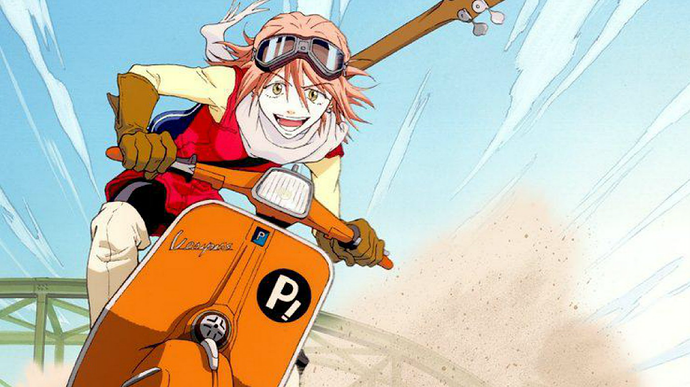FLCL and Little Busters
FLCL and Little Busters are two series that at first sight have almost nothing to do with each other. In fact, I wouldn’t have noticed any of this if it wasn’t for the coincidence that the title of the Key VN is the same as the name of the album from The Pillows that was used as FLCL’s soundtrack.
However, I started to wonder, was it a coincidence really?
What is FLCL?
First of all, since some of you may not have watched or even know what FLCL is; it’s a 2001 OVA Anime made by Gainax, the studio who was also behind Neon Genesis Evangelion.
The series is about a young boy named Naota Takeba, who has to deal with the emotional aftermath of his brother leaving his small hometown to live in the United States. However, it’s not only his emotional baggage that he has to confront; as he also has to help his brother’s girlfriend, Mamimi Samejima, who was devastated due to this.
This is until a crazy motorcycle riding woman named Haruhara Haruko bursts onto the scene, completely changing both Mamimi’s and Naota’s life.
The series is notorious for its high levels of absurdist and non-sensical scenes that in actuality all hold a deeper meaning to the characters and the story’s narrative.
How does it relate to Little Busters?
Both stories share very similar themes of growing up and dealing with emotional dependency towards a role model. Although Little Busters takes a more literal route that actually shows a lot of the inner conflicts of the characters, FLCL instead takes a more symbolic approach using various different metaphors and letting the watcher’s take away what they will from it. Along with that although Little Busters doesn’t touch much in the sexual side of maturity, FLCL decides to tackle it head-on.
First of all, both stories feature an older male role model that takes care of the MCs these being Kyousuke and Tasuku (Naota’s brother).
Both Riki and Naota look up to them and are dependent on then to a large extent due to their lack of reliable parental figures in Naota’s case, or in Riki’s case the lack of any at all.
In fact, the main focus of both stories’ is the focus on their protagonists as they lose this figure, along with having to deal with another person that was close to them losing them, being Mamimi and Rin. Both of Mamimi and Rin were extremely dependent on the role models as well, in fact being considerably worse off in this aspect than the main characters themselves.
Both MCs also can’t cope with this loss, until they are changed by external factors such as Haruko and the newer members of the Little Busters. These help the main character eventually become strong enough to confront the situation and overcome it in their own different ways.
This leads me to my next point and the reason I think these two use baseball as a metaphor for growing up in very similar ways.
Now, baseball as a metaphor for this is actually pretty common especially in Japanese and American media, since in both cultures baseball is arguably the most well regarded and widely practiced sport, or at least was at one point, however, there are various common factors that make the connection
In episode 4 of FLCL, there’s a scene at the start in which Naota is playing a baseball game with his grandpa and a few of the local folk. Their team is losing pretty badly, and this is all the fault of Haruko who’s playing with the opposite team and is singlehandedly making Naota’s team lose. At the face of this, along with the memories of his brother, Naota gives up and lets his team lose by doing absolutely nothing until the game ends. This leads Haruko to say to Naota that “Nothing can happen until you swing the bat”
This scene can be related to the infamous “CHEAP TRICKS” scene, in which Riki can do nothing but watch as Kengo fails to hit the ball, and the game is lost.
Both are basically being told by their role models (By this point Naota had already started seeing Haruko as a replacement for his brother) that they are not strong enough to win and that they’ll fail if they try.
This ties into my next scenes of comparison, Naota swinging the bat and Riki’s narcolepsy.
At the end of the same episode, a giant baseball asteroid (Random I know) is going to hit Naota’s hometown and destroy it. Naota at the face of this is forced by Haruko to go up and “swing the bat” in order to send it away. As the baseball starts to collide with earth, Naota swings at it with a giant guitar and struggles to hit it away, going so far as to call to his brother for help. However, Naota confronts his fears and hits the asteroid into outer space, overcoming his fear of not having his brother to help him and finally being independent.
All of these points are shared by Riki’s first awakening and him facing his narcolepsy. Him being forced to face his fears and to become independent by the Little Busters is Haruko forcing Naota to swing the bat. The baseball asteroid is the scene of carnage when Riki wakes up, seeing the imminent danger to all his friends. Naota calling for his brother is represented by Riki falling asleep at the face of his fears, not being able to fight them himself. And finally swinging the bat is Riki going into his memories and dealing with his deep-rooted emotional issues caused by the loss of his parents, which finally allows change to happen.
And finally, there’s the last episode of FLCL and Riki rescuing all his schoolmates. This is the fruits of overcoming their fears, this is the change that happens when they let go of their pasts, and when they manage to surpass their role model’s expectations with Riki managing to save everyone, and Naota fighting and basically defeating Haruko. This is the climax of both stories, and when they finally manage to clear all the turmoil clouding their emotions.
All of these similarities in character arcs and the narrative message is what leads me to believe that Little Busters took some inspiration from FLCL
IN CONCLUSION?
I personally think both Little Busters and FLCL are two stories that manage the topic of growing up perfectly in their own different ways. Even though both take very unique approaches, in the end, they both convey similar messaged in a very beautiful way.
Whether you think LB may be based on FLCL is up to you, and it can seem a bit of a stretch, but it’s something I personally believe it is.
Thank you for reading, and if you haven’t already, please watch FLCL. I tried to go light on the spoilers for it and it’s an amazing series that can be enjoyed even when spoiled.




